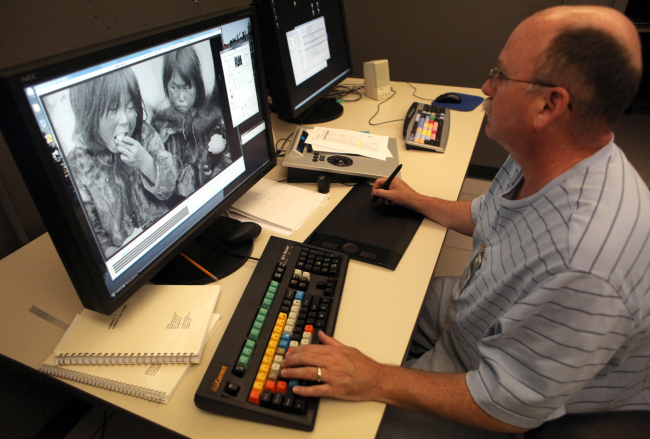CULPEPER, Virginia (AP) ― In the crisp 4-degree Celsius air of a converted bunker in rural Virginia lies the U.S.’s greatest collection of early film.
Stacked in metal tins on shelves in 124 concrete vaults that stretch almost 2.5-meters high, movies that wowed audiences decades ago are meticulously stored so that one day, they may play again.
The vaults at the Library of Congress’ Packard Campus for Audio-Visual Conservation in Culpeper, Virginia, represent decades of work by copyright officials to not only protect the rights of filmmakers, but also preserve their movies for future generations.
The collection is in many ways the culmination of work that began 100 years ago Friday, when U.S.-made movies earned their own copyright designation and transformed from a fledgling industry into a global economic and cultural juggernaut.

This undated publicity photo released by the Library of Congress shows John Carter, a digital film preservation specialist, working on a film in the Digital Restoration Lab at the Packard Campus of the National Audio-Visual Conservation Center, in Culpeper, Virginia. (AP-Yonhap News)
“Copyright was very essential from the very beginning of the industry,’’ said Patrick Loughney, chief of the Packard campus, a former Federal Reserve bunker 90 minutes west of Washington, D.C., that has been converted into a state-of-the-art archive. It is a dual safe-haven, intended to protect both the film’s creators and, in the process, establish a collection that outlasts a film’s box-office haul.
“It’s basically been a Noah’s Ark effort to save the creative history of the United States,’’ he said.
Congress carved out a film copyright designation on Aug. 24, 1912, and within weeks, filmmakers were registering their dramas, documentaries and comedies. The first was “Black Sheep’s Wool,’’ a melodrama about the troubles of European nobility who came to North America.
It, like many films of its age, is lost. But the Packard Campus does have the only known copy of the fourth film registered, a 1912 version of “The Charge of the Light Brigade’’ created by Thomas Edison’s film company.
Fragments of another of the first five films registered remain in another archive run by New York’s Museum of Modern Art, he said, but the rest are currently considered lost.
Although more than 5,600 earlier films had received copyright protection, Loughney and others say creating a film category reflected its growing influence and the desire to see it protected.






